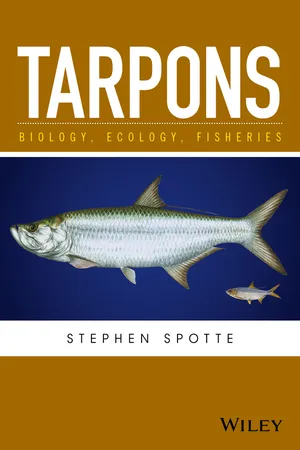
Tarpons
Biology, Ecology, Fisheries
Stephen Spotte
- English
- ePUB (handyfreundlich)
- Über iOS und Android verfügbar
Tarpons
Biology, Ecology, Fisheries
Stephen Spotte
Über dieses Buch
Stephen Spotte, Mote Marine Laboratory, Sarasota, Florida, USA
Tarpons arose from an ancient lineage, and just two species exist today, confined to the tropics and subtropics: Megalops atlanticus in the western and eastern Atlantic and Megalops cyprinoides distributed widely across the Indo-West Pacific. The Atlantic tarpon is considered king of the saltwater sport fishes and supports a multi-billion dollar recreational fishery in the U.S. alone. The Pacific tarpon, which is much smaller, is less valued by anglers. Both have limited commercial value but offer considerable potential for future aquaculture because of their hardiness, rapid growth, and ease of adaptation to captivity.
This book is the latest and most thorough text on the biology, ecology, and fisheries (sport and commercial) of tarpons. The chapters comprise clear, intricate discourses on such subjects as early development and metamorphosis, population genetics, anatomical and physiological features and adaptations, migrations, reproductive biology, and culminate with a concise overview of the world's tarpon fisheries. A comprehensive appendix includes Spotte's original translations of important papers published previously by others in Spanish and Portuguese and unavailable until now to English readers.
Tarpons: Biology, Ecology, Fisheries will be of considerable interest and use to fishery and research biologists, marine conservationists, aquaculturists, and informed anglers
Häufig gestellte Fragen
Information
CHAPTER 1
Development
1.1 Introduction
1.2 The tarpon leptocephalus
“In conversation with Mr. S. A. Venable of the Zone Police Force [Panamá Canal Zone Police], an experienced [Atlantic] tarpon fisherman, I was informed that the fish is viviparous. He has repeatedly observed the females seeking shallow water, generally less than 4 feet deep, where a continuous stream of young fish was poured from her vent, the young being apparently little more than ¼-inch long. The young immediately seek refuge in groups, under the large scales of the mother, each scale standing outward at an angle of probably 30°. The young clustered in these scale shelters as thickly as they could. Mr. Venable’s many observations lead him to believe that the young shelter under the scales ten days or more, when they are ¾-inch long. The mother soon rids herself of the young by shaking herself and by leaping.”


1.3 Staging tarpon ontogeny
Inhaltsverzeichnis
- Cover
- Title Page
- Table of Contents
- Preface
- Acknowledgements
- Symbols and abbreviations
- CHAPTER 1: Development
- CHAPTER 2: Growth
- CHAPTER 3: Spawning
- CHAPTER 4: Recruitment
- CHAPTER 5: Breathing and respiration
- CHAPTER 6: Osmo- and ionoregulation
- CHAPTER 7: Ecology
- CHAPTER 8: Fisheries
- APPENDIX A: Partial list of countries where Atlantic and Pacific tarpons have been reported
- APPENDIX B: Contribución a la morfología y organogenésis de los leptocéfalos del sábalo Megalops atlanticus (Pisces: Megalopidae)
- APPENDIX C: Desarrollo temprano del sábalo, Megalops atlanticus (Pisces: Megalopidae)Early development of the tarpon, Megalops atlanticus (Pisces: Megalopidae)
- APPENDIX D: Aspectos biométricos de una población de sábalo, Megalops atlanticus (Pisces: Megalopidae)Biometric aspects of a tarpon population, Megalops atlanticus (Pisces: Megalopidae)
- APPENDIX E
- APPENDIX F: Sôbre a alimentação do camurupim, Tarpon atlanticus (Valenciennes), no Estado do CearáOn food of the tarpon, Tarpon atlanticus (Valenciennes), in the State of Ceará
- APPENDIX G: Ecología básica y alimentación del sábalo Megalops atlanticus (Pisces: Megalopidae)
- APPENDIX H: Ensaio preliminary sobre o cultivo camurupim (megalops [sic] atlanticus) em viveiros escavados e sua ocorrência em lagoas marginais no litoral de Tutóia – Ma
- APPENDIX I: Sobre a elaboração de conservas de pescado em leite de côco em óleos de algodão e de babaçu
- APPENDIX J: Industrialização da ova do camurupim, Tarpon atlanticus (Valenciennes)
- References
- Index
- End User License Agreement